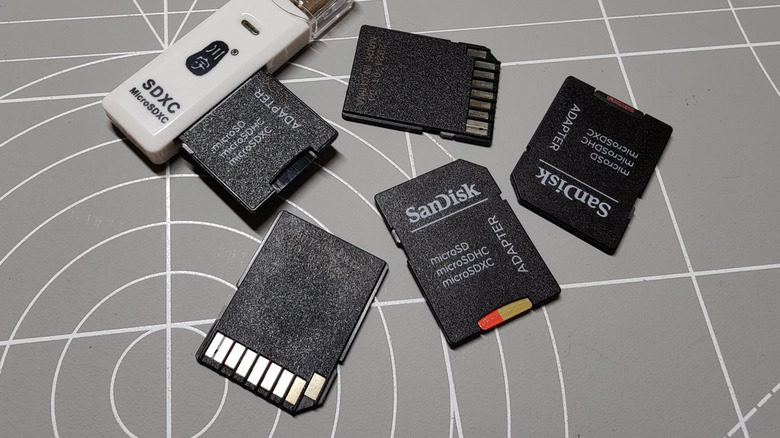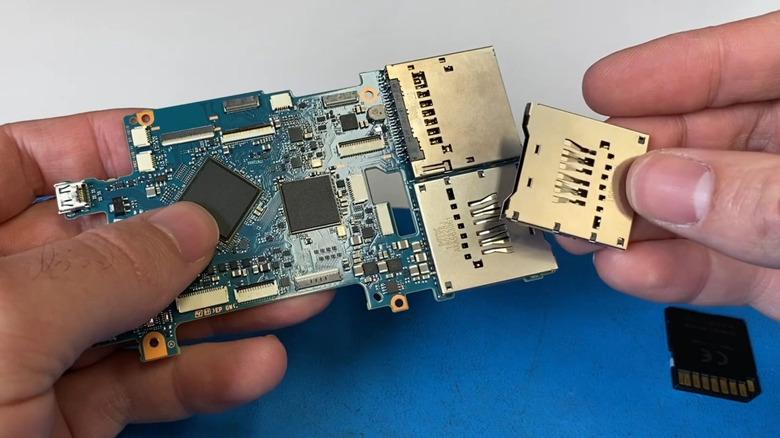Ever Noticed The Little Switch On An SD Card? Here's What It's For
If you own any portable device manufactured in the last two decades, chances are you have had to buy a fair share of the removable flash memory cards. That's the tiny bits of plastic and silicon holding all your media on your smartphone, digital camera, or handheld gaming console. The prevalent standard for portable flash storage, the SD card, was developed by the SD Association and is available in the standard, mini, and micro form factors, with storage capacities ranging from a modest 2GB to a theoretical 128TB. There's nothing particularly complicated about the microSD variety, whereas hardware manufacturers seem to have forgotten about miniSD cards altogether. But our interest lies squarely in the postage-stamp sized SD cards, or rather the mysteries of the tiny sliding switch found on them.
Located on the upper half of the SD card along one of the long edges, the switch prevents the host device from deleting or otherwise modifying the data stored on the card when it is slid down to the locked position. Pushing the switch back to the top position takes it out of the read-only mode, which allows data to be read from and written to the card. However, none of that functionality is guaranteed in practice. Let's look into why it's a bad idea to rely on the write-protect switch to secure your data from being accidentally overwritten.
Why you shouldn't rely on the write protect switch
Tearing down an SD card to its bare internals reveals why the write protect switch doesn't guarantee the data from being overwritten. The sliding switch is just a piece of plastic that isn't electrically connected to the actual PCB housing the flash memory chips. The switch's position is detected by a spring-loaded strip of metal on the SD card reader. Depending on whether you set the switch to the locked or unlocked state on the card, it pushes one of the two metal spring contacts on the card reader, which is how it can tell whether or not it is allowed to overwrite the data.
Because the write-protect switch on the SD card cannot physically prevent the data from being modified, this functionality relies in the host device to be equipped with the hardware capability to detect the physical position of the write protection slide switch on the SD card. This is often true for no-name SD card readers, especially the kinds that only house the card partially. Such card readers don't adhere to the SD Association's design guidelines and lack the means to support any form of write protection. If you're looking for one without these issues, we have compiled a list of six of 2024's best SD card readers for your convenience.
On the flip side, devices bearing SD card slots manufactured by reputed electronics brands are guaranteed to detect and honor the write protection status on your card. In other words, it's fine to insert a write protected SD card in your Sony or Canon camera and expect it to be safe, but that isn't guaranteed universally.
The write protection feature has created more headaches for users
If the idea of critical data security measure being left to the whims and fancies of third-party device vendors sounds terrible, that's because it genuinely is a bad idea. You're better off considering these best ways to backup you data and applying best practices therein to safefguard the contents of your SD card. The write protection switch is a convenient failsafe to quickly prevent your camera from overwriting SD cards bearing your cherished photos. However, this shouldn't be your only line of defense against data loss.
Worse yet, this vestigial data security measure has the potential to cause more headaches. Your SD card is permanently stuck in the write protected mode if the plastic nub falls off for any reason. That's because the card reader is designed to err on the side of caution if the inserted card doesn't trigger either of the sense pins. These issues weren't lost on the SD Association either. That's precisely why the future iterations of SD cards, namely the miniSD and microSD, didn't bother incorporating any write protection measures.


